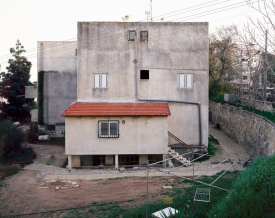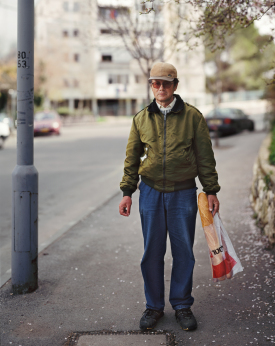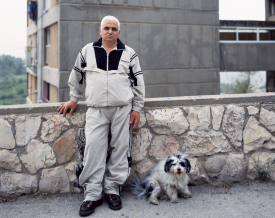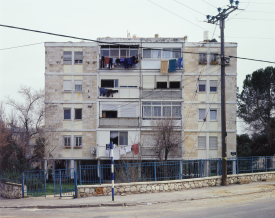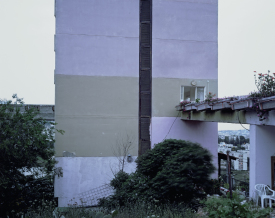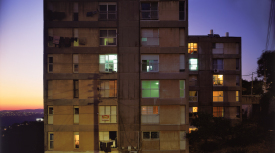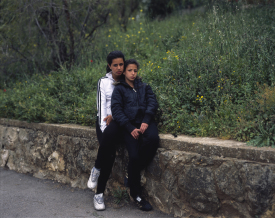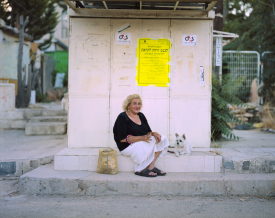Yaakov Israel
by Mark Long
Yaakov Israel grew up in Kiryat HaYovel in Jerusalem, where he lives still. He started making photographic portraits of the people and the buildings in South West Jerusalem as an undergraduate student, using large-format cameras to make images sumptuous in detail. For nearly twenty years Israel’s approach has been to photograph the neighborhoods’ inhabitants going about their everyday lives amid workaday buildings depicted as though they were historic monuments or mansions of the rich. By showcasing the allure of these places through this familiar visual language, Israel’s photographs allow us to look anew at the neighborhoods and see beyond any preconceived notions we might have about this part of the city.
These are photographs made to dignify these spaces, an important part of Jerusalem that is never part of any tourist itinerary. They underscore the monumentality of the buildings that together map South West Jerusalem onto the shifting territory of one of the world’s oldest cities. The images function as invitations: to visit the neighborhoods and to encounter the buildings in person, perhaps, but also, certainly, to wonder about the people who live behind these windows and walls.
The neighborhoods of South West Jerusalem—Kiryat HaYovel, Kiryat Menachem, and Katamonim—were established in the 1950s as transitional housing solutions for the many immigrants arriving in Israel in the early years after independence, even as many locals were displaced in turn. These public-housing solutions materialized in a repetitive format, varying from small buildings divided into two 33- or 37-square-meter (355 or 398 square feet) apartments, low two-story buildings with four to eight apartments, and big socialist-inspired apartment blocks with two- and three-room apartments (the larger of them 47 square meters [506 square feet] in size). Over the years they became home to many working-class people.
Israel’s determination to see working-class Jerusalem equitably permeates this work. It accounts for his decision to make the images in flat light. Except for the portraits, where the individuals pictured are the central focus of the image, there is no hierarchy in the photographs. Every element is deserving of attention and our eyes are empowered to range from foreground to background and across the extent of the places pictured, from individual buildings to clusters of homes to bigger sections of neighborhoods. We can distinguish with equal clarity the most mundane elements, like bedsheets, blue jeans and undershirts hung out to dry, and the more startling, such as aerial walkways designed to fit many of the neighborhoods’ apartment blocks into the hilly topography of the city. Always, Israel’s intention is that viewers should immerse themselves in the images in order to see more fully his South West Jerusalem before it is lost to looming processes of urban renewal and gentrification.
Yaakov Israel
Born in Jerusalem, Israel (1974)
Lives and works in Jerusalem
Yaakov Israel earned a BFA in Photography at the Bezalel Academy of Arts and Design, Jerusalem in 2002. Israel focuses on long-term independent projects, which reflect on the way the religious, social, and political affect and create his personal reality. His gaze is constantly investigating Israeli identity as perceived through architecture, landscape, and the country’s diverse population.
Israel’s photographs are in the collections of The Knesset, Jerusalem, Israel; Haifa Museum of Art, Israel; The Open Museum of Photography at Tel-Hai, Israel; and Ashdod Art Museum, Israel. He is the recipient awards such as the PHotoESPAÑA Descubrimientos PHE12 Award (2012) and two grants from The Israel Lottery Council for Culture & Arts (2014 and 2018), among others.
Yaakov Israel’s work was featured at the Halsey Institute in 2014 in The Quest for the Man on the White Donkey.
Mark Long
Trained in Ireland, Spain, and the United States, political geographer Dr. Mark Long is Professor of Political Science and Curator at Large and Academic Liaison at the Halsey Institute of Contemporary Art at the College of Charleston. He earned his MA at the University of Ireland, Cork and his Ph.D. in Geography at the University of South Carolina. Long’s research is concerned with the intersections between visual culture and place. Long has published papers and essays on subjects from street art to editorial cartoons, anti-Americanism, and landscape photography in Israel. In his work as a curator, he has curated shows of landscape photography from Antarctica to Afghanistan to the American West by award-winning American and international artists, including Simon Norfolk’s Et in Acardia Ego, Pedro Lobo’s architecture of survival, Stuart Klipper’s Antarctica, as well Southbound: Photographs of and about the New South, which featured work by fifty-six photographers.

